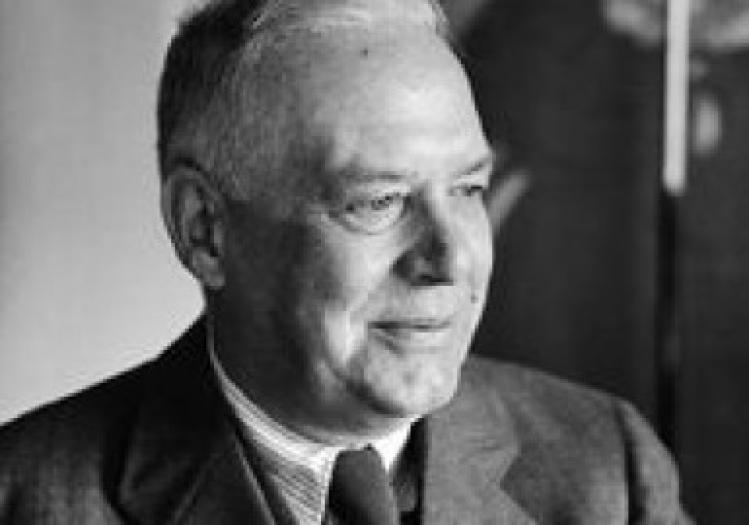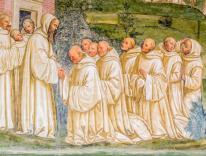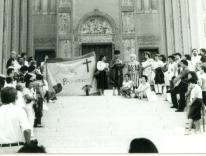
Did Wallace Stevens, one of the greatest twentieth-century poets, convert to Roman Catholicism as he lay dying in the summer of 1955? This question has provoked more controversy than one might expect. In Wallace Stevens’ Supreme Fiction: A New Romanticism (1987), Joseph Carroll provided a synopsis of the debate, offering the testimony of the Catholic priest who claimed to have initiated Stevens into the faith—and of the poet’s daughter, Holly, who strenuously denied the priest’s claim. Whatever the truth of the matter, careful readers of Stevens’s poetry would not be surprised if he did in fact convert on his deathbed, since much of his later poetry reflects, and is shaped by, what we may call a “Catholic imagination.”
Born in 1879 in Reading, Pennsylvania, Stevens grew up influenced by his father’s very American kind of Christianity, one that put great emphasis on self-reliance and the rewards of hard work. His mother was pious in the more traditional sense, and the young Stevens was familiar with the Bible, especially the New Testament; significantly, he was also drawn to quiet places where meditation was fostered, and would remain so all his life. But Stevens was his father’s son to the end, and so put the advancement of his legal career before his poetry. By the time he wrote the poems I want to discuss here, he had become a successful insurance lawyer and vice president of the Hartford Insurance Company, a married man with a daughter and a house in the suburbs. Safely ensconced in this bourgeois life, Stevens could take all the risks he wanted to in his poetry.
In a 1942 lecture Stevens spoke of the need for a space free for contemplation. That last word is crucial, since for Stevens, poetry grows out of contemplation. His second book, Ideas of Order (1935), is a collection of tightly interrelated poems written in response to certain philosophical problems involving transcendence and its relationship to belief. As Stevens was putting the book together in 1935, he described a group of its poems as “an abridgement of at least a temporary theory of poetry.” (He was a poet for whom most things were “temporary,” and theories especially.) In a letter to his editor describing what was originally the first poem in Ideas of Order, “Sailing After Lunch,” Stevens provided a clue to this theory. “When people speak of the romantic,” he wrote, “they do so in what the French commonly call a pejorative sense. But poetry is essentially romantic, only the romantic of poetry must be something constantly new and, therefore, just the opposite of what is spoken of as the romantic. Without this romantic, one gets nowhere; with it, the most casual things take on a transcendence, and the poet rushes brightly.” Romance is the essential thing in poetry, in other words, but it continually risks becoming stale. Thus Stevens writes, in “Sailing After Lunch”:
The romantic should be here.
The romantic should be there.
It ought to be everywhere. But the romantic must never remain,
Mon Dieu, and must never return again.
In a 1940 letter Stevens remarked that “what the world looks forward to is a new romanticism, a new belief”; and in “How to Live. What to Do.”—a poem that “definitely represents my way of thinking,” Stevens asserted —we see his reformulation of Wordsworth’s romanticism, especially as it was presented in “Tintern Abbey.” In Stevens’s poem, a man and his companion leave “the flame-freaked sun / To seek a sun of fuller fire,” but end up finding only “this tufted rock / Massively rising high and bare.” There is nothing else there, “neither voice nor crested image, / Nor chorister, nor priest”; yet the poem ends with a triumph, as the cold wind makes a “heroic sound / Joyous and jubilant and sure.” While Wordsworth and his companion look on the world and hear “the still sad music of humanity,” Stevens and his companion hear the desolate but heroic wind. This is a new kind of romanticism.
But is it a Catholic kind? In “The American Sublime,” Stevens asks, “How does one stand / To behold the sublime...?” and goes on to answer, “the sublime comes down / To the spirit itself, / The spirit and space, / The empty spirit / In vacant space. / What wine does one drink? / What bread does one eat?” Such questions evoke the Eucharist, yet the romanticism of Ideas of Order cannot fairly be described as Catholic. Indeed, the most important poem in the volume would seem to undermine the claim that Stevens was in any way a religious poet. In “Evening without Angels,” the poet notes that “sad men made angels of the sun,” and that banishing these angels, we have returned to “bare earth,” where “the voice that is in us makes true response…” Angels, like the bread and wine of the Eucharist, are an outmoded invention; we’re better off in a “disenchanted world,” where a fully human voice finally rises up and responds “truly” to the world outside. This is a romanticism without angels, indeed without any of the traditional paraphernalia of religion. This is transcendence without the supernatural.
If we stopped here, we could agree with critics who see a secular Stevens intent on the realization of purely human powers. But Stevens’s work developed over time. In 1941, six years after the publication of Ideas of Order, he delivered a lecture, “The Noble Rider and the Sound of Words,” that shows him continuing to worry about the nature and role of the romantic. Stevens wants to counter what he views as a pervasive “spirit of negation,” which denies “all the great things,” but he now seems less sure that “the romantic” offers “the way out.” Six years later still, in 1947, he is even more nervous about this word, writing in “Imagination as Value” that “the imagination is the liberty of the mind. The romantic is a failure to make use of that liberty. It is to the imagination what sentimentality is to feeling.” It seems Stevens now wants to sever the romantic from the imagination as he strives to comprehend the latter in the fullness of its powers.
Indeed, one could use this growing comprehension of the power of the imagination to chart the development of Stevens’s poetry. His 1942 collection Parts of a World reveals a strategy designed to strip away the romantic quest for higher things as an obstacle to rapprochement with the world. In “The Man on the Dump,” the poet imagines “rejecting the trash” of romantic imagery to feel the purifying change, “the moment when the moon creeps up to the bubbling of bassoons,” when “everything is shed” and we are empowered. As “On the Road Home” quite clearly tells us, “It was when I said, / ‘There is no such thing as the truth,’” that the poet sees the world more fully and experiences life with superlatives: “warmest, closest, and strongest.” And the very next poem, “The Latest Freed Man,” tells us that “having just / Escaped from the truth, the morning is color and mist, / Which is enough.” We achieve satisfying sensory experience when we give up the romantic quest for higher, transcendent things.
Later poems in the volume, however, recognize that this effort of sweeping away entails subsequently finding something that will suffice. “The Well Dressed Man with a Beard” begins with this recognition, using language from Carlyle: “After the final no there comes a yes / And on that yes the future world depends.” Of the protagonist in “Mrs. Alfred Uruguay” we learn that “Her no and no made yes impossible,” yet someone passes by her who can bring us to yes, a “figure of capable imagination.” This is the figure we aspire to become, equipped with an imagination capable of creating “the ultimate elegance, the imagined land.”
This poem leads us in turn to the most important poem in the volume, “Asides on the Oboe,” whose opening contains of one of the most important phrases in Stevens’s entire body of poetry:
The prologues are over. It is a question, now,
Of final belief. So, say that final belief
Must be in a fiction. It is time to choose.
It’s as if Stevens believes that all he has done up to this point, in all his work to date, has been prologue to this moment, when we are (finally!) ready to understand what is at stake—namely, belief, and final belief at that. We are asked to choose what fiction we will believe in. And this challenge leads to what most critics consider Stevens’s greatest poem, Notes Toward a Supreme Fiction, finished at the end of May 1942.
Any attempt to talk about one aspect of such a complex poem is bound to be misleading, but we may focus on two ideas we have been sketching: angels and belief. As the poem comes to its final climax, the poet at last discovers a way “To find the real, / To be stripped of every fiction except one / The fiction of an absolute—Angel, / Be silent in your luminous cloud and hear / The luminous melody of proper sound.” That we find the real by stripping away fictions should come as no surprise. But what may startle is the news that we require a fiction, that of the absolute, and that this one fiction is associated with the kind of being banished by this secular poet. Fictions are made things, constructed by the power called the imagination, and the only one Stevens allows back into his world is the fiction of an absolute order and perspective, a way of looking unbounded by time or space—like that of the angels we thought he had denied.
Stevens then asks the ultimate question: “What am I to believe?” By way of responding, he imagines the now necessary angel “leaping downwards through evening’s revelations” and asks, “Am I that imagine this angel less satisfied?” The answer is no. Through the angel the poet achieves an “expressible bliss” by creating, through the power of the imagination, an angelic way of looking and hearing, he is able to find what suffices—and to assert, quite boldly, that “I can / Do all that angels can.” A later poem, “Angel Surrounded by Paysans,” provides the best gloss:
Yet I am the necessary angel of earth,
Since, in my sight, you see the earth again,
Cleared of its stiff and stubborn, man-locked set,
And, in my hearing, you hear its tragic drone
Rise liquidly in liquid lingerings,
Like watery words awash.
Beyond romantic sentimentality, these lines express what the imagination is capable of giving us, angelic sight and hearing. Stevens plays the angel in another late poem, “One of the Inhabitants of the West”:
“I am the archangel of evening and praise
This one star’s blaze.
Suppose it was a drop of blood...
So much guilt lies buried
Beneath the innocence
Of autumn days.”
As his title suggests, Stevens recognizes the angel as a product of the same Western theological imagination that enables us to retain innocence even after Hiroshima and Auschwitz. The earlier banishment of angels now seems merely a stage in the clearing-out process preliminary to the poet’s imaginative attempt to be both man and angel, both timeless and temporal—to occupy what T. S. Eliot called “the point of intersection of the timeless with time.”
Does this make Stevens a Christian poet? One final look at a poem may help us feel more secure in this assertion. “St. Armorer’s Church from the Outside” addresses the matter of a decaying church and an imaginative effort at renewal. At the time the poem was written, the foundation of the Episcopal Church of the Good Shepherd in Hartford, Connecticut, was rotting and causing the 150-foot steeple to lean. The name Stevens gives the church, “St. Armorer’s,” is inspired by the gun engravings in the entrance, or “armorer’s porch”—the church was built by the Colt firearms family—and suggests wittily a once-mighty edifice clearly fallen from its former strength. But the poet begins constructing, in the space outside St. Armorer’s and beneath its now-leaning tower, a chapel: “something seen / In a mystic eye, no sign of life but life, / Itself, the presence of the intelligible.” The chapel is the poet’s creation, from nature and in the presence of the outmoded church, of something new:
St. Armorer’s has nothing of this present,
This vif, this dizzle-dazzle of being new
And of becoming, for which the chapel spreads out
Its arches in its vivid element,
In the air of newness of that element,
In an air of freshness, clearness, greenness, blueness,
That which is always beginning because it is part
Of that which is always beginning, over and over.
The church is always beginning over and over, and the poet’s job is to help that process of renewal, of maintaining the ancient strength in a fresh new element. I for one am prepared to accept that Stevens made a conversion to the Catholic Church as he lay dying, since so much of his poetic work had prepared him for finding a way to live comfortably and securely in its light. The poem ends simply:
The chapel underneath St. Armorer’s walls,
Stands in a light, its natural light and day,
The origin and keep of its health and his own.
And there he walks and does as he lives and likes.
Please email comments to [email protected] and join the conversation on our Facebook page.
Share
Previous Story
All At Sea
Next Story
Journet’s Blind Spot

